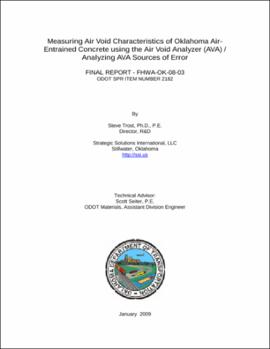| dc.creator | Trost, Steve | |
| dc.date.accessioned | 2018-04-20T22:47:26Z | |
| dc.date.available | 2018-04-20T22:47:26Z | |
| dc.date.issued | 2009-1 | |
| dc.identifier.govdoc | FHWA-OK-08-03 | |
| dc.identifier.other | Oklahoma Department of Transportation State Planning and Research item 2128 | |
| dc.identifier.uri | https://hdl.handle.net/11244/299496 | |
| dc.description.abstract | The conventional method for measuring the size distribution of air voids in concrete (ASTM C457) requires a technician with highly-specialized training and can only be performed on hardened concrete. Waiting several days or even weeks for the concrete to harden enough to be tested does not provide the timely feedback needed for adequate quality control of the concrete’s air void structure. To overcome this problem, a Danish company (Dansk Beton Teknik) developed a device to measure the size distribution of air in fresh concrete. The device, known as the Air Void Analyzer (AVA), relies on Stoke’s law to measure bubble size distribution by timing the bubbles as they rise through a column of glycerol and water. The Oklahoma Department of Transportation contracted with Strategic Solutions International, LLC to use the AVA to quantify the air void characteristics of standard air-entrained concrete mixes in Oklahoma and to quantify the sources of error inherent in AVA measurements. The investigation included the following broad tasks: 1. Quantify the air void characteristics of standard mixes being used throughout the state of Oklahoma using the Air Void Analyzer (AVA); 2. Quantify the sources of sampling and testing error inherent in the AVA test procedures and equipment; and 3. Develop and evaluate modifications to the AVA test procedures and/or equipment to improve the precision of the measurements. The investigation revealed the following: ? Seventy-five percent of mixes tested had their average Spacing Factor above the 0.010-inch threshold. ? Sixty-five percent of the mixes tested had their 95% Lower Confidence Limit above the 0.010-inch threshold. ? Pumping bridge concrete using a conventional pump truck increased the measured Spacing Factor by 0.0018 inches on average. ? The temperature of the liquids in the AVA riser column was found to be the most influential source of potential error. In addition, temperature sensing and control capabilities of the current AVA equipment were found to be lacking, especially in light of the strong influence of temperature on the measured results. | |
| dc.format.extent | 56 pages | |
| dc.format.extent | 1,112,532 bytes | |
| dc.format.medium | application.pdf | |
| dc.language | en_US | |
| dc.relation.ispartofseries | No | |
| dc.relation.requires | Adobe Acrobat Reader | |
| dc.relation.uri | http://www.okladot.state.ok.us/hqdiv/p-r-div/spr-rip/library/reports/fhwa-ok0803.pdf | |
| dc.title | Measuring Air Void Characteristics of Oklahoma Air- Entrained Concrete using the Air Void Analyzer (AVA) / Analyzing AVA Sources of Error (FHWA-OK-08-03 2128) | |
| dc.type | Technical Report | |
| dc.description.version | Final Report, April 2007-Septembcer 2008 | |
| dc.description.peerreview | No | |
| dc.type.material | text | |
| dc.subject.keywords | Concrete | |
| dc.subject.keywords | air voids | |
| dc.subject.keywords | air void analyzer | |
| dc.subject.keywords | AVA | |
| dc.subject.keywords | spacing factor | |
| dc.subject.keywords | specific surface | |
| dc.subject.keywords | freeze/thaw durability | |
| dc.contributor.sponsor | Oklahoma Department of Transportation. Materials and Research Division. Office of Research & Implementation | |
